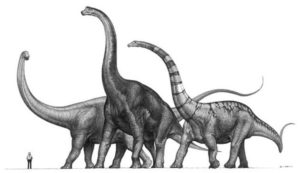Updated on: 28/03/2022
Ultrasaurus is a genus of gigantic dinosaurs that lived about 100 to 110 million years ago.
| Kingdom: | Animalia |
| Phylum: | Chordata |
| Class: | Reptilia |
| Clade: | Dinosauria |
| Suborder: | Sauropodomorpha |
| Clade: | Neosauropoda |
| Genus: | Ultrasaurus |
| Species: | U. tabriensis |
| Name Meaning: | Ultra lizard |
| Geological Time Period: | Aptian/Albian stages of early Cretaceous |
| Size: | 82 – 100 ft (25-30 m) long 50 ft (15 m) high |
| Weight: | 55 – 130 tons |
| Location: | South Korea (Asia) |
| Diet: | Herbivorous |
| Birth type: | Eggs |
| Locomotion: | Quadrupedal |
Ultrasaurus was discovered by Kim Haang Mook in South Korea in the year 1983. However, in 1979, Jim Jensen of Brigham Young University used this name to unofficially describe dinosaur fossils, which he found at Dry Mesa Quarry, Colorado.
But before Jensen could officially declare his discovery, Kim Haang published the name “Ultrasaurus,” and thus Jensen had to rename his specimen to “Ultrasauros.”
However, Jensen’s findings were considered a “chimera” since the fossil he found belonged to two distinct dinosaurs – Brachiosaurus and Supersaurus.

Their front legs reached a height of nearly 25 feet while their neck measured 60 feet in length. They had a relatively short tail.
Like Ultrasaurus, Diplodocus and Argentinosaurus too were plant-eating dinosaurs with similar body structure. Diplodocus was a native of North America during the late Jurassic period while Argentinosaurus inhabited Argentina during the Late Cretaceous Period.
Among the three Sauropods, Diplodocus is considered the largest with an approximate length of 25 meters.
They were terrestrial animals living in herds, migrating from one place to another in search of food. Fossil studies have revealed that they laid their eggs in a linear pattern. It is believed that the parent Ultrasaurus did not care for their young ones.
No substantial data exists but it is assumed that the Cretaceous- Tertiary mass extinction event might have wiped them out.
Natural enemies like Allosaurus and its relative Ceratosaurus used to prey upon the baby as well as the old and sick Ultrasaurus.